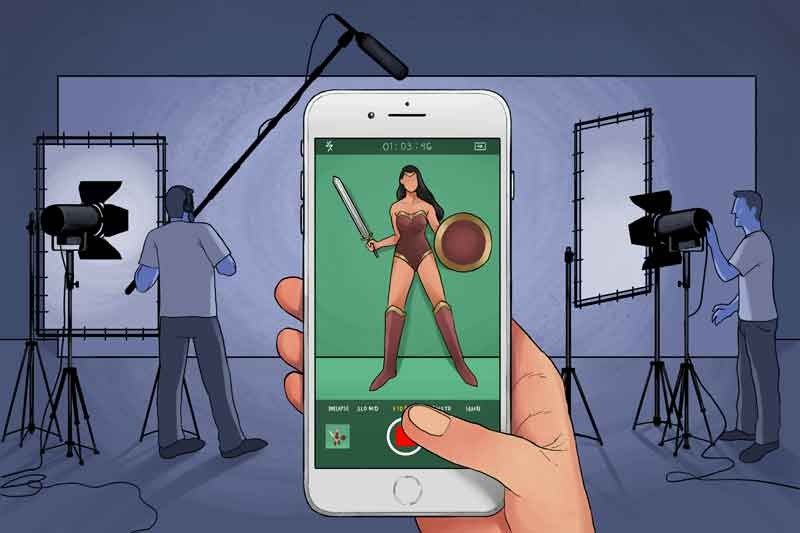Aspect Ratio

The formerly blasphemous vertical video found itself the main attraction of a film festival contest. Could this be the future of film?
MANILA, Philippines — The advent of digital filmmaking has created a generation of storytellers, no longer burdened by the high budgets of the celluloid era. While digital video and DSLRs have changed the game for professionals and amateur filmmakers, the ubiquitous cellphone camera brought video to the masses. For some, though, cellphone footage has brought with it a certain aesthetic disaster: the vertical video. A telltale sign of the non-filmmaker, vertical video is seen as an ugly and lazy method of video recording. And why not? You capture less of the scene, and most displays that aren’t phones (like computer monitors and film screens) are horizontal, bringing about the dreaded large black bars on the sides of the playing video. Disgraceful.
Or is it? Away from the fanfare of the main competitions of 2018’s Cinemalaya, Nespresso sponsored a competition: three-minute short films centering on the concept of “empathy.” And they had to be shot vertically.
The formerly blasphemous aspect ratio now found itself the main attraction of a film festival contest. By the time the festival rolled around, the contest featured 12 finalists whose works were judged by Patrick Pesengco, managing director of Novateur Coffee Concepts, Inc., Chris Martinez of Ang Babae Sa Septic Tank fame, and Madonna Tarrayo, president and CEO of Unitel Productions Inc. and Straight Shooters Media. Surrounded by industry professionals, these filmmakers were fighting for the spotlight and, on the whole, they delivered.
It’s hard to tell when exactly the stigma around vertical video started. The idea grew as a meme arising from sites like YouTube and Reddit, touting correct horizontal display as being a sign of intelligence and “better” filmmaking. Horizontal video was seen as the “correct” way due to our visual sense of a natural horizontal placement. Some blamed Steve Jobs and the iPhone for creating “Vertical Video Syndrome,” or the inability to turn a phone 90 degrees and “shoot correctly.” As a format, it became associated with banal mass media and the rise of the selfie culture. Some even call it a “digital sin.”
But vertical video has had a long running history, even before the advent of social media. Russian filmmaker Sergei Eisenstein fought for a “dynamic square” cinema screen, capable of accepting different aspect ratios, including vertically shot film footage (which the Academy of Motion Picture Arts and Sciences effectively rejected by making the 1.375:1 ratio standard in cinemas). Brian Eno created “Thursday Afternoon,” a series of vertical “video paintings” in 1984. With the coming of digital film and smartphones, it became even easier to film vertically. In fact some in the industry would find shooting vertically to be a necessity in today’s age.
With so much branded content and advertising on social media, filming vertically is unavoidable. Instagram Stories doesn’t even support filming in landscape. Advertisers, ever ready to find the best ways to catch the attention of consumers, know that the best strategy is to catch them mid-browse, and in an uninterrupted manner. Having to tilt your screen to view an ad is an instant turnoff; having the ad play in vertical makes the process seamless.
“This is the first time Cinemalaya has done something like this,” said Madonna Tarrayo, one of the judges. “It’s good to see that they’re exploring different kinds of formats.” She went on to say that the vertical film contest was something different to look forward to, away from the main competitions dominated by horizontal video.
“We were looking for how they used vertical video,” said Chris Martinez after the screenings. “They have to really use the orientation to their advantage. ‘Di pwede na ginawang vertical lang dahil ’yun ang nakalagay sa rules.”
Joining the awards night proper, the Nespresso Vertical Shorts winners found themselves on the same stage as the main competitors. Ako by Jonel Revistual bagged second runner-up, while Braveheart by Kevin Tuason took home the first runner-up prize. SLN by Brian Spencer Reyes, a touching film about a mausoleum cleaner having a conversation with a forgotten grave, walked away with the Best Film award in the category. The oft-derided format stood on the same platform as its horizontal brethren and it stood, well, tall.
It’s hard to really tell whether or not vertical video will ever overtake horizontal as the dominant format. The associations with a cinematic look and the overwhelming precedent make it seem impossible. What can be argued, however, is that there is a growing space within the film world for vertical video to shine. Art never stops at predetermined boundaries, and with the rise of more and more digital formats, we have to start accepting the inevitable rise of verticality in our cinema. There will be more contests, more filmmakers, and more stories that will need it. No need to turn it 90 degrees.















